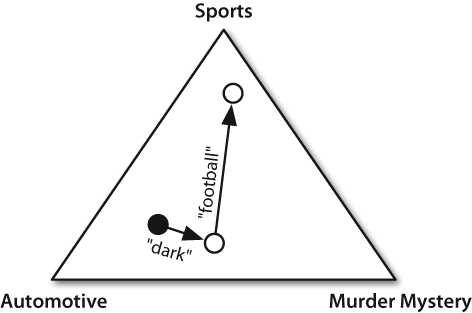Naive Bayes Classifiers
In naive Bayes classifiers, every feature gets a say in determining which label should be assigned to a given input value. To choose a label for an input value, the naive Bayes classifier begins by calculating the prior probability of each label, which is determined by checking the frequency of each label in the training set. The contribution from each feature is then combined with this prior probability, to arrive at a likelihood estimate for each label. The label whose likelihood estimate is the highest is then assigned to the input value. Figure 6-6 illustrates this process.

Figure 6-6. An abstract illustration of the procedure used by the naive Bayes classifier to choose the topic for a document. In the training corpus, most documents are automotive, so the classifier starts out at a point closer to the “automotive” label. But it then considers the effect of each feature. In this example, the input document contains the word dark, which is a weak indicator for murder mysteries, but it also contains the word football, which is a strong indicator for sports documents. After every feature has made its contribution, the classifier checks which label it is closest to, and assigns that label to the input.
Individual features make their contribution to the overall decision by “voting against” labels that don’t occur with that feature very often. In particular, the ...
Get Natural Language Processing with Python now with the O’Reilly learning platform.
O’Reilly members experience books, live events, courses curated by job role, and more from O’Reilly and nearly 200 top publishers.

